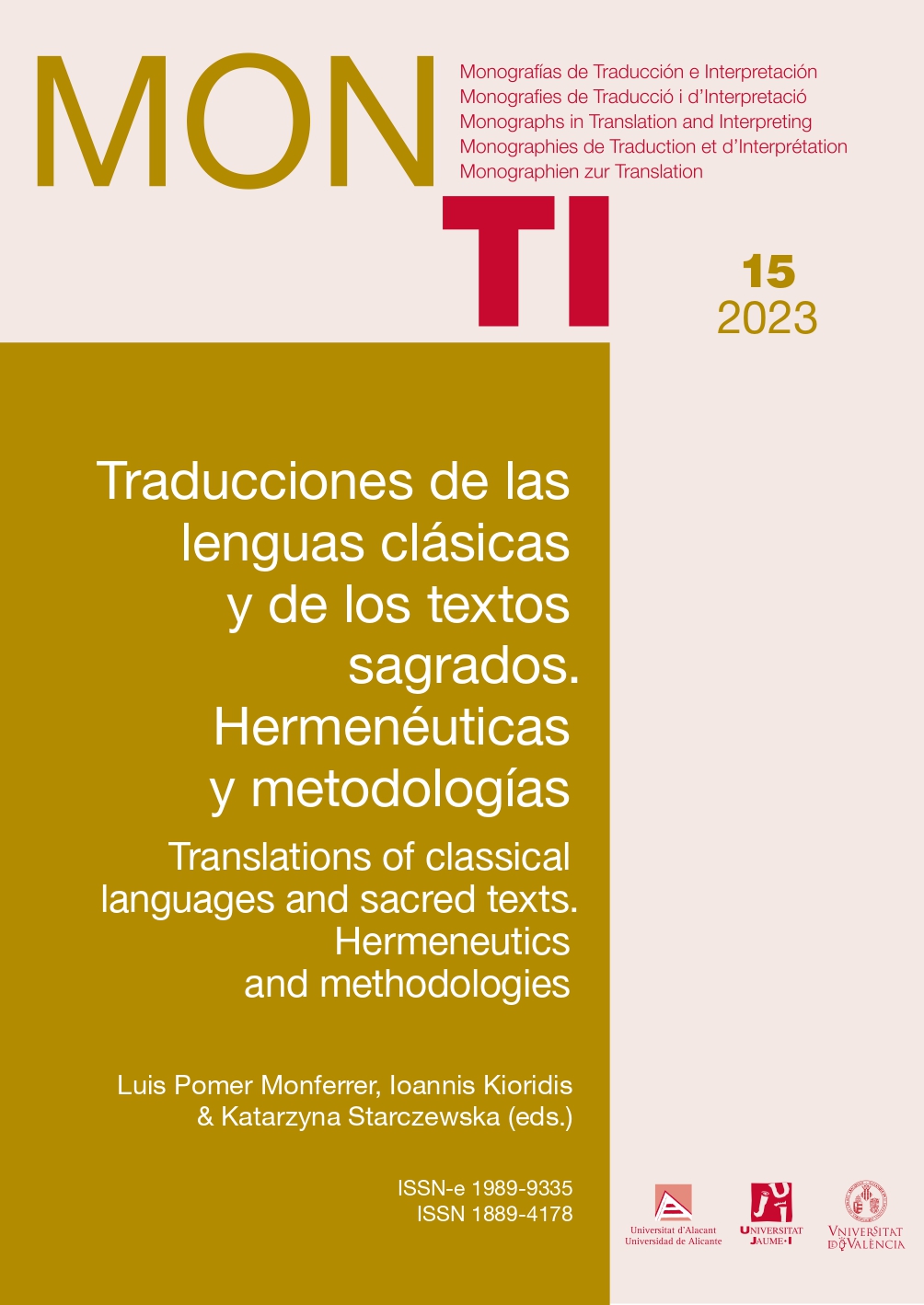La traducción bíblica: ¿estrategias diferentes producen textos divergentes?
Contenido principal del artículo
Resumen
En el presente trabajo pretendemos comprobar la efectividad de las diferentes “estrategias de traducción” aplicadas a la traducción de la Biblia cristiana a través de un análisis histórico y textual de diversas versiones bíblicas a algunas lenguas vernáculas de Occidente (alemán y español). Dada la particularidad antropológica de los libros que la componen (el postulado de su inspiración divina), la posible aplicación de una estrategia traductiva dependerá del posicionamiento que frente al carácter sagrado del texto mantenga el posible traductor: si la considera un texto sacro e intocable, si admite la variación del tenor formal del texto mientras se salve el mensaje nuclear, o si, en orden a facilitar la fácil lectura y captación del mensaje, se permiten mayores alteraciones textuales. Comprobaremos si la estrategia de traducción (implícita o explícita) ha sido realmente decisiva a la hora de producir traducciones no coincidentes, tanto en el sentido, como en la literalidad y la literariedad (legibilidad) de los mismos.
Descargas
Detalles del artículo
La propiedad intelectual de los artículos pertenece a los autores y los derechos de edición y publicación, a la revista. Los artículos publicados en la revista podrán ser usados libremente para propósitos educativos y científicos, siempre y cuando se realice una correcta citación del mismo. Cualquier uso comercial queda expresamente penado por la ley.
Citas
BARRERA, Trebolle. (1998) The Jewish Bible and the Christian Bible. Leiden: Brill Eerdman.
Biblia del Oso. (1569) BIBLIATODO. Versión electrónica: htpp://www.bibliatodo.com/La-biblia-del-oso-1569/Cantares-1
BIBLIOTECA DE AUTORES CRISTIANOS. (1993) Epistolario. 2ª ed. a cargo de J. Bautista Valero. Madrid: SJ.
CICERÓN, Marco Tulio. (46 a. C.) De optimo genere oratorum. Biblioteca Virtual Miguel de Cervantes. Versión electrónica: https://www.cervantesvirtual.com/portales/tovar/obras/materia/ciceron-marco-tulio-de-optimo-genere-oratorum-17196
DE ENZINAS, Francisco. (1543) Nuevo Testamento traducido por Francisco de Enzinas. Antwerpen: P. Mierdman. Versión electrónica: https://archive.org/details/NTDeEnzinas/page/n9/mode/2up
DE LEÓN, Fray Luis. (1559) Cantar de cantares de Salomón. Edición de Javier San José Leta. Biblioteca Virtual Miguel de Cervantes. Versión electrónica: https://www.cervantesvirtual.com/obra-visor/cantar-de-cantares-de-salomon--0/html/01e17fb4-82b2-11df-acc7-002185ce6064_2.html
DE REINA, Casiodoro. (1569) “Introducción [a la Biblia].” En: Sagradas Escrituras Versión Antigua. Transcrita y puesta en español actual por Russell Martin Stendal en su revisión de 1996. Texto extraído de la edición digital presentada por Equipo Biblioteca Hispana Internacional (2019): https://esword-espanol.blogspot.com/2018/08/stendal1996-sagradas-escrituras-version.html
FÜRST, Alfons. (2004) Hieronymus. Askese und Wissenschaft in der Spätantike. Basel: Herder.
HUMBOLDT, Wilhelm von. (1820/1822) “Über das vergleichende Sprachstudium in Beziehung auf die verschiedenen Epochen der Sprachentwicklung.” En: Abhandlungen der Königlichen Akademie der Wissenschaften zu Berlin aus den Jahren 1820-1821. Berlin: Brandenburgische Akademie der Wissenschaften, pp. 239-260.
KING JAMES BIBLE. Versión electrónica: https://www.kingjamesbibleonline.org/
LANCELLE, Rüdiger. (2002) Hoffnung fuer alle. Ulm: International Bible Society.
LUTERO, Martín. (1530/2002) Sendbrief vom Dolmetschen/Del arte de traducir. Edición y traducción de Tobias Brandenberger. Madrid: Caparrós editores.
Lutherbibel. (1545) New Christian Bible Study. Versión electrónica: https://newchristianbiblestudy.org/bible/german-luther-1545/song-of-solomon
REISS, Katherina. (1976) Texttyp und Ubersetzungsmethode. Kronberg: Scriptor-Verlag.
SCHLEIERMACHER, Friedrich. (1813) Über die verschiedenen Methoden des Übersetzens. Berlin: De Gruyter Mouton.
SAN JERÓNIMO. (1993) De optimo genere interpretandi. En: Epistolario I. Traducción, introducción y notas de Juan Bautista Valero. Madrid: BAC.
SAN JERÓNIMO. (2002) Obras completas. Comentario a Mateo y otros escritos. Madrid: BAC.
SIMMEL, Oskar & Rudolf Stählin. (1958) Die christliche Religion. Frankfurt: Fischer Verlag.
STENDAL, Russell Martin. (1996) Sagradas Escrituras. Versión Antigua. EBH Internacional. 2019. Versión electrónica:
https://esword-espanol.blogspot.com/2018/08/stendal1996-sagradas-escrituras-version.html
VARIOS AUTORES. (1980) Einheitsübersetzung der Heiligen Schrift. Stuttgart: Katholische Bibelanstalt GmbH. Versión electrónica: https://bibel.github.io/EUe/
VARIOS AUTORES. (2004) Die Bibel. Einheits Ubersetzung. Altes und Neues Testament. Freiburg im Breisgau: Herder.
VEGA, Miguel Ángel. (1994) Textos clásicos de teoría de la traducción. Madrid: Cátedra.
VINAY, Jean Paul & Jean Darbelnet. (1958) Stilistique comparée de français et de l’anglais. Paris: Didier.
ZUBER, Roger. (1968) Les belles infideles et la formation du goût classique: Perrot d’Ablancourt et Guez de Balzac. Paris: Editorial Champion.


